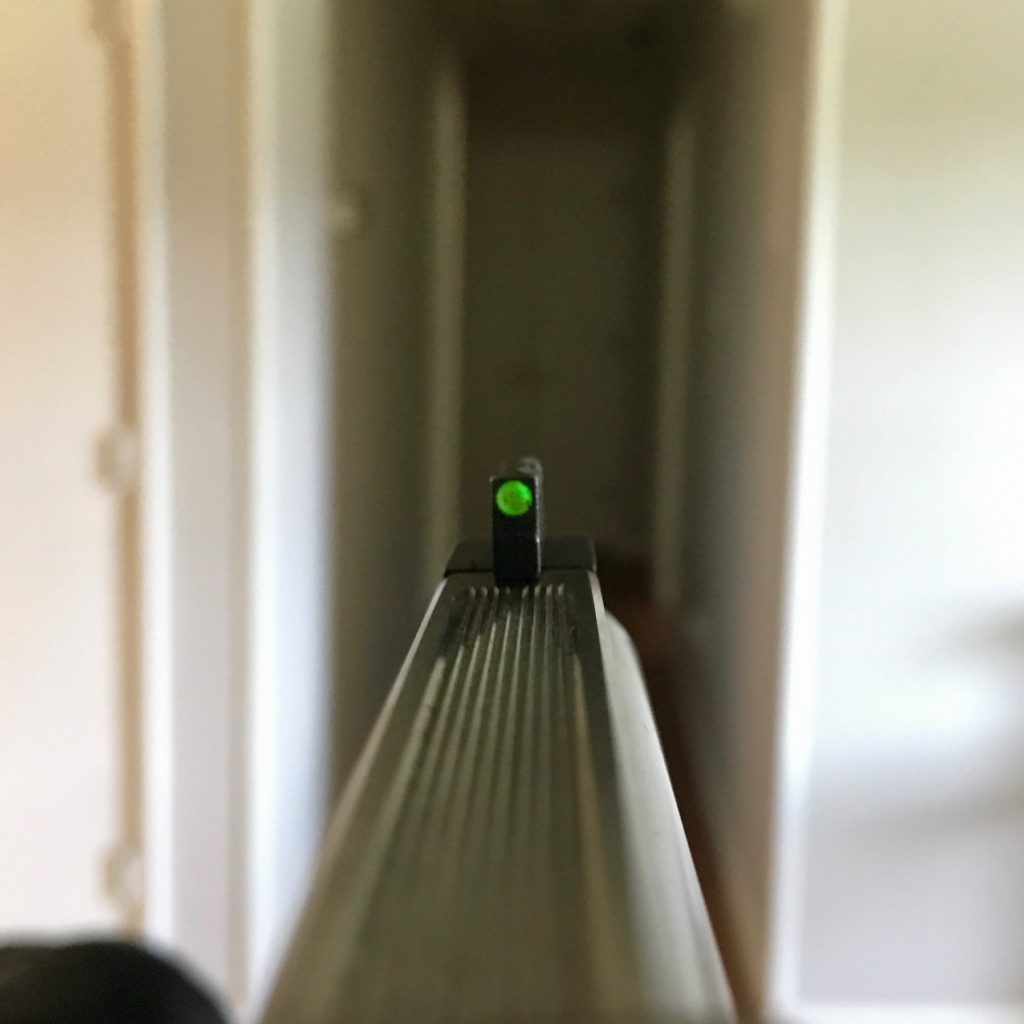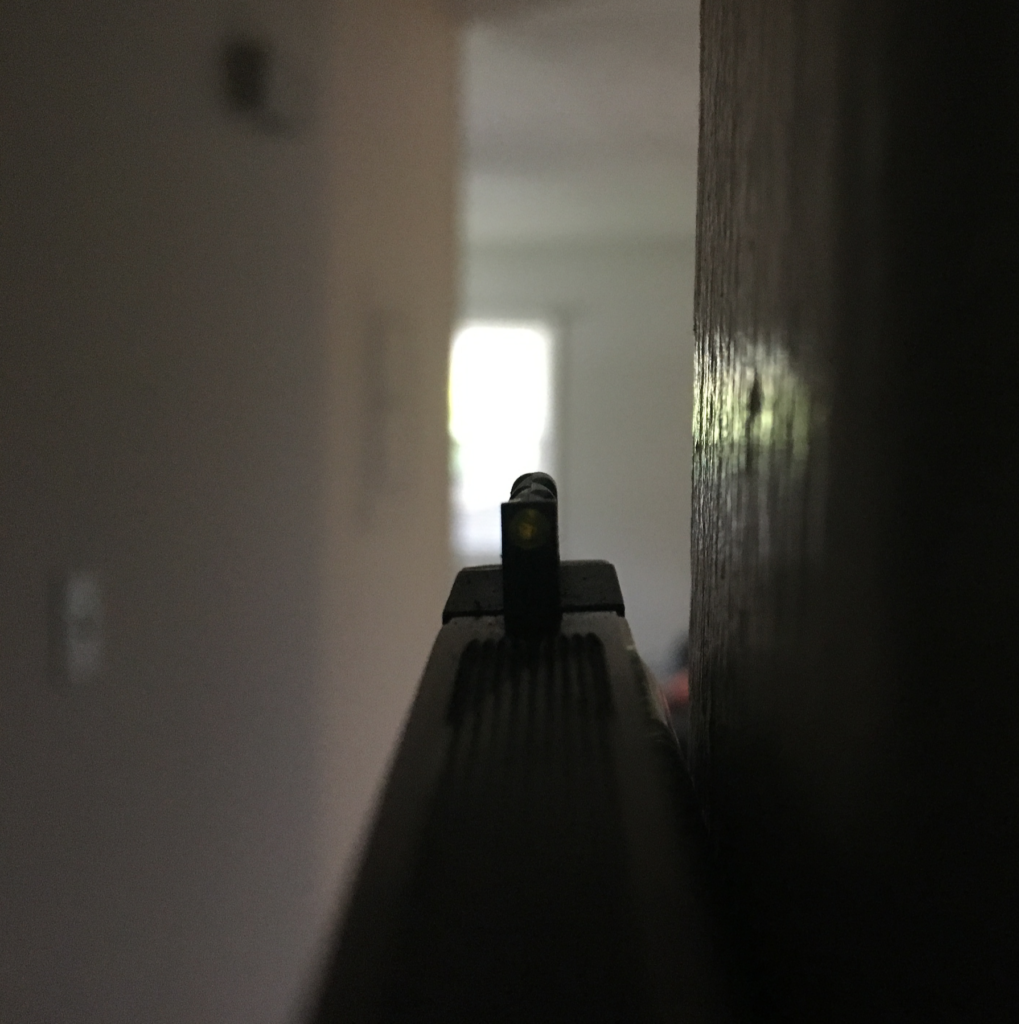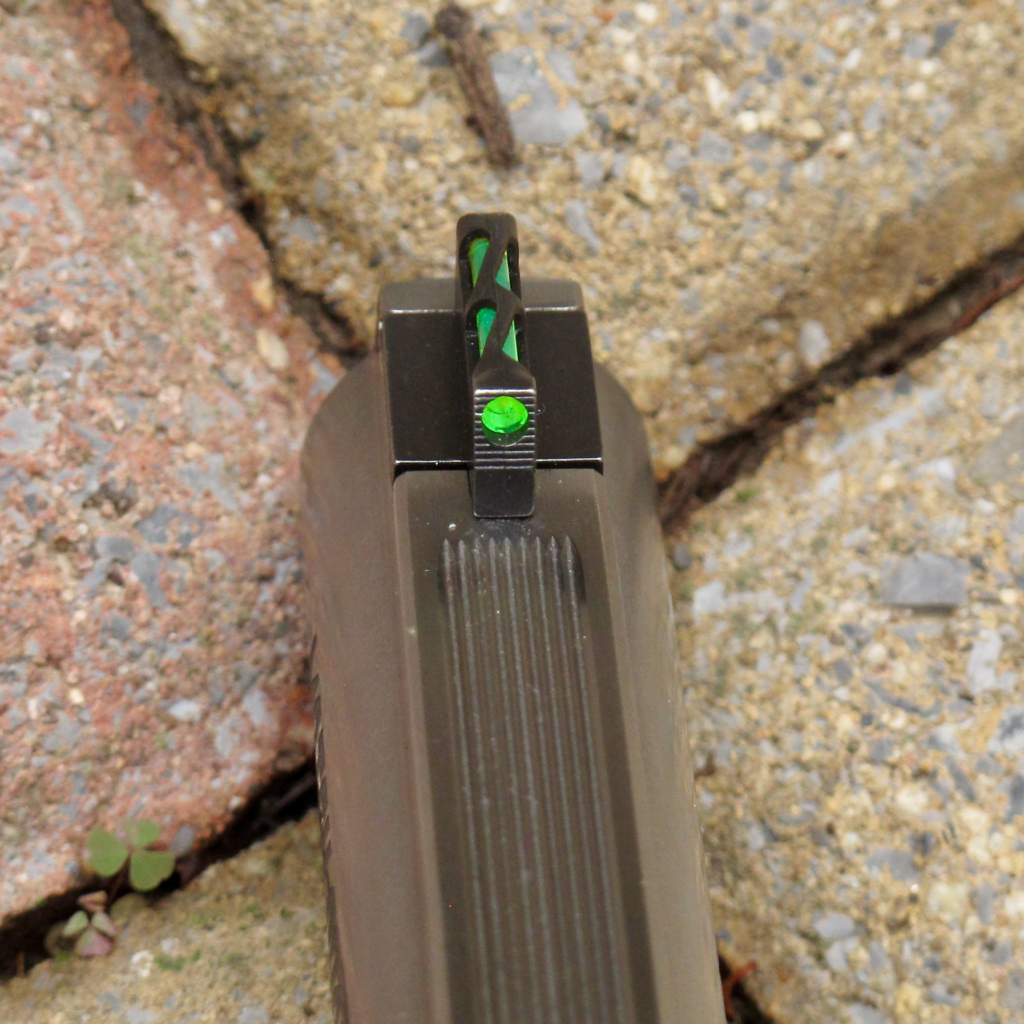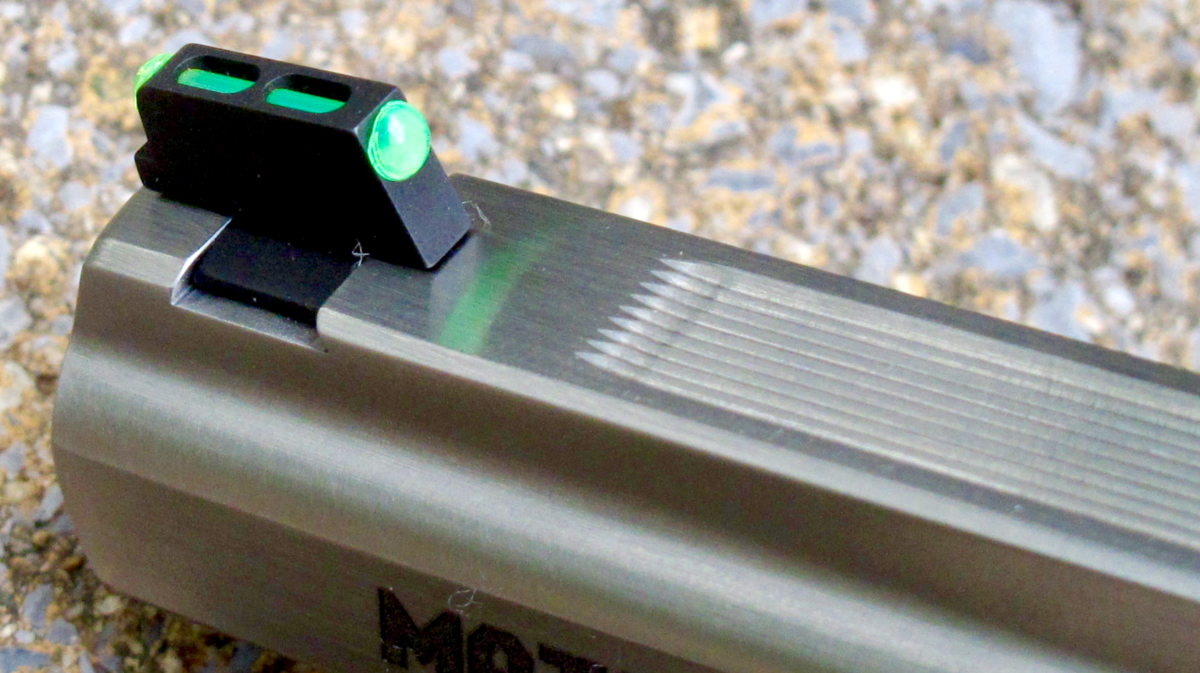I seem to be in a minority. A lot of shooters seem to really like fiber-optic sights, but I don’t. Not even a little, and this post will explore that a bit. The main reason I don’t like them: consistency. This really hit home with me during some shooting with the 10mm GP100.
Why I Don’t Like Fiber-Optic Sights
During a couple of sessions with this revolver, I had to shoot at indoor ranges. One of these ranges was very well lit, but the other one wasn’t. At this second range I noticed that it was bright enough for me to see the sights and bright enough to positively identify the target. Heck, it was even bright enough for me to be OK conducting my accuracy “test” of the GP100. Despite this, it wasn’t bright enough in the booth to “activate” the fiber rod in the GP’s front sight.

This essentially left me working with a plain black blade, which is fine with me. However, what this demonstrates is that fiber optic sights only work sometimes. Even if we rarely are in true “darkness,” lighting is almost never consistent across large (or small) areas. This gets to the crux of my argument: we buy fiber optic sights because they help us see the sights faster, but they may completely fail to provide this benefit when it is needed most.

Secondarily, I don’t believe fiber-optic sights are as durable as all-steel sights. This is a sub-concern, and depends largely on the individual sight’s design. The fiber rod must be exposed to light to gather light, and this is typically the weak link. I have seen several sights sling the fiber rod into the great unknown. With the GP100’s well-protected fiber rod I don’t think this is a huge concern, but with some designs it definitely is. If you use fiber optic sights I think you should choose them carefully.

Don’t Believe Everything I Say
There are some credible arguments against and fixes for the consistency issue. The first is that all those bright, sunny-day range sessions build “muscle-memory” (more technically, myelinate neural pathways) that make presentation of the gun natural and perhaps somewhat reduce reliance on the sights. I buy this somewhat; I am extremely comfortable with my carry gun and can consistently present it well, even with my eyes closed. That doesn’t mean I don’t want to be able to see my sights, though.

If you love fiber-optic sights and can’t live without them but also want a low light capability, there is also a very worthwhile solution: Kyle Lamb’s VTAC sights. Mr. Lamb recognized that fiber optics don’t work in some lighting conditions, so his sights have fiber rods and tritium tubes. Of course these sights are only available for a select few handguns, but I see a lot of merit in the idea.
The Bottom Line
Some of my dislike of fiber-optic sights is personal preference. However, I do think the consistency issue is something you should consider. If you only run your gun on an outdoor range or a well-lit indoor range, try to get into some different lighting conditions. Maybe you’ll find they work for your needs. . .or maybe not. But you won’t know until you mess around with it a bit. For my money, though, if a benefit is worth paying for, it’s also worth making sure it will be there when I need it most.


Also not a big fan of fibers on a handgun, but it’s not a real breaker. I found the same issue on my .44 GP100, when the ambient light is too dim. Fixed it the same way I fixed eight visibility problems on the other pistols–a liberal application of Sight Visibility Enhancement Compound. This compound is available in a multitude of colors, so it’s easy to pick the one that shows up best for you in life-long situations.
For a small fee, I’m willing to do a custom application for almost anybody; just ship me your gun and a $10 bill, and I’ll get it back to sometime. Or, for DIY’ers, you can find this compound by visiting the Wal-Mart cosmetics aisle, and checking the fingernail polish rack. Ace
Ace, everybody knows you can’t do business without a website these days. If you need help picking a URL, lemme know. I think http://www.orange_blob_on_my_front_sight.com might work, or maybe, http://www.pimp_my_front_sight.com?
Just tryin’ to help a friend.
; ^ )
Mike TruGlo makes tritium/fiber optic sights for quite some time, and for a number of guns. I have one gun with fiber-optic only and am waiting for the time that I feel good enough to change them, for the same reasons you mentioned. Sadly no one makes sights for revolvers with that combination. Heck I’d only charge you 5 bucks+ shipping to do the same work,and use model paint two choices florescent orange or green. Love your articles keep up the good work.
Bandaid.
Great to see you here, Sir! Sounds like we need to get the manufacturers on the ball, to fill the gaps in the product line.
I find the fiber-optic I put on my GP100 superior to the black ramp that came with it, though I could have painted it, as I did on my fixed-sights guns with these:
https://www.amazon.com/Birchwood-Casey-Super-Bright-Green/dp/B00JSAE234
I’d rate the pens as “okay” and used them on two of our guns.
Yes, a TruGlo for revolvers would rule, as would a Streamlight laser/light combo like the one recently released for 1911s without a rail. I plan to buy one of those and will ask Streamlight (ok, lobby them) for ones that might fit a K-frame or GP100. Crimson Trace are fine but I want some light, too, even at the cost of revealing my location.
I’ve found the big glowing orb distracts my eye from the clear, precise top edge of the front sight.
Anyone else favor a plain black rear with a tritium vial up front (no dots)? Acts like plain target sights in good light, easy to find the front quickly in low light, but the glow doesn’t overpower a clear focus on that top edge.
Just got a meprolight tritium insert that fits the dovetail on the old S&W front ramps that hold the orange plastic nubbins we know and love/hate. Works with the factory rear and seems simple to install. Should know soon if it’s worth the $30.
I always do take a sharpie to the rear dots; one dot in front equals no confusion under stress!
Agreed. Save the juggling for the circus.
At 50 years old, and having no Lasik surgery or prescription glasses, I wonder what Fiber-Optic sights can do for my eyes. As it is, I use the factory standard S&W red ramp on all my revolvers….and the sights are blurry, and the supposed-to-appear horizontal notch in the rear sight is slanted from right to left at about a 30 degree angle. Yep, that’s my sight picture and I tend to shoot far to the left with every gun I pick up. I was just wondering if any other old geezers shared my problem…and do you find that Fiber-Optic sights reduce or amplify the blurriness…or…are they no better or worse than the standard S&W sights.
Brian, we’re the same age and my front sights turned fuzzy several years ago too. The major advantage to the fiber optic is that it’s brighter, but I don’t find that it makes things more clear. The low light scenarios where I struggle to get a clear view of the front sight (like a darkened indoor range) aren’t helped very much, if at all, by the fiber optic in my experience. There doesn’t seem to be enough light to “activate” the fiber. Unfortunately, in full sun, the fiber optic can bloom so brightly that it can sometimes make it even more difficult to identify the top edge of the front sight. If your sights are regulated such that you can use the fiber optic to place your rounds accurately, then you’re good, but if your sights are set up so that rounds impact above the top edge of the front blade, the fiber optic can make that tougher to achieve.
I think it would be a dandy sight for reflexive shooting–perhaps wingshooting, or even for defensive/game use where distances are short, times are fast, and targets are generous–but I don’t think it’s a great target sight at all.
Hope that helps.
One other thing–it sounds as if you might have an astigmatism. I have one too, and the prescription lenses are VERY helpful in fixing that. I’d highly encourage you to look into some prescription shooting glasses, even if you don’t want to wear corrective lenses on a daily basis.
Brian, I’m 63–it gets worse. I despise fiber optics, and for reasons not mentioned elsewhere. Essentially they present a florescent sight picture, and human eyes were not built to get a good, clear, in-focus sight picture on anything florescent. You cannot do your best work with florescent colors (sights or targets, I might add). Bright colors are okay, white seems the best. For those of you worried about shooting in the dark, worry about about target identification first. Sure, you may well have to shoot when you can ID the target but can’t see your front sight very clearly. That’s when you need to have some experience and myelinate neural pathways established with SOME FORM of target focus shooting, point shooting, or whatever you wish to call it. the late great Jim cirillo used to teach simply using your entire gun as a “sight” when that was all you had or all you could see. Practice that.
Thanks for the replies Mike. Some good information there. It’s a tough decision to make…as usually is with choosing sights for revolvers. The good news for me is that at present, I’m mainly looking at the idea of fiberoptic sights on my EDC revolver which has a 2.6 barrel. At 21 yards – which according to our data and training, is where the bad guy always stands – precision shooting isn’t a major issue. My initial thoughts on fiber optics and eyesight problem is that perhaps colors can substitute for crispness – meaning that if our standard sights tend to blur into one – then perhaps fiber optic sights will only require our aging eyes to separate two colors. Hope that last one makes sense, but what I’m trying to say is I suspect it is easier for our eyes to put the green between the two reds…as opposed to the more precise task of perfectly aligning front post and notch. In my own case, I sometimes feel like I’m seeing two front sight posts LOL.
Oh yeah, I get it! I have always been a fan of the red ramp and have made a habit of painting all of my plain blades (revolver and auto) with some red-orange model paint (over a base layer of white). The contrast has always been a help, especially in fast moving conditions.
I think the fiber optic is worth a try for the job you describe. Just realize that it won’t do much in reduced light (unless you get one that’s supplemented by tritium) and look for one that’s robust enough for daily carry. That latter issue can be a problem with the FO sights, as Justin mentioned.
I’m curious . . . which revolver are we talking about? There aren’t many that can easily accept FOs without some gunsmithing, and the selection of FO sights for revolvers is pretty slim.
Oops I forgot about this discussion. I managed to relocate the set of sights that I was referring to. If you know of any problems with these, please don’t hesitate to tell me…us. Thanks.
https://www.speedbeez.com/product/lpa-txt-fiber-optic-target-tactical-sight-set-for-sw-revolvers-black-finish/
My problem is just the reverse I like my fiber optic sights, but My GP 100’s REAR sight blends into the black on targets, making it difficult to get a good sight picture
Oh well, persevere and overcome!
Stay tuned, Carl – I have an article coming about some replacement options for both front and rear sights for the GP100!
For me, I prefer tritium for self defense guns and fiber optic for my hunting revolvers. The reason being that tritium/white dot gives me the most visible sight picture in indoor settings. Fiber optic shows up best at twilight on brown/black fur.
It’s important to realize not all FO sights are created equal. Some are just terrible. Others ok (High Vis). Others great (Dawson Precision). I personally dislike tritium. Reason mainly that it is too bright in very low light and makes my pupil shrink. FO adjusts somewhat to light level (like your eyes). And they work well with flashlights, usually intercepting plenty of stray light even in total darkness. I do a lot of night shooting and dawn/dusk whitetail hunting with my handgun. No doubt to me a FO is better than plain irons. But it is true that cheap FO is blob-like and lacks precision that iron offers. Good FO like Dawson delivers nearly the strength and all the precision with the benefit of a little dot when you may need it.